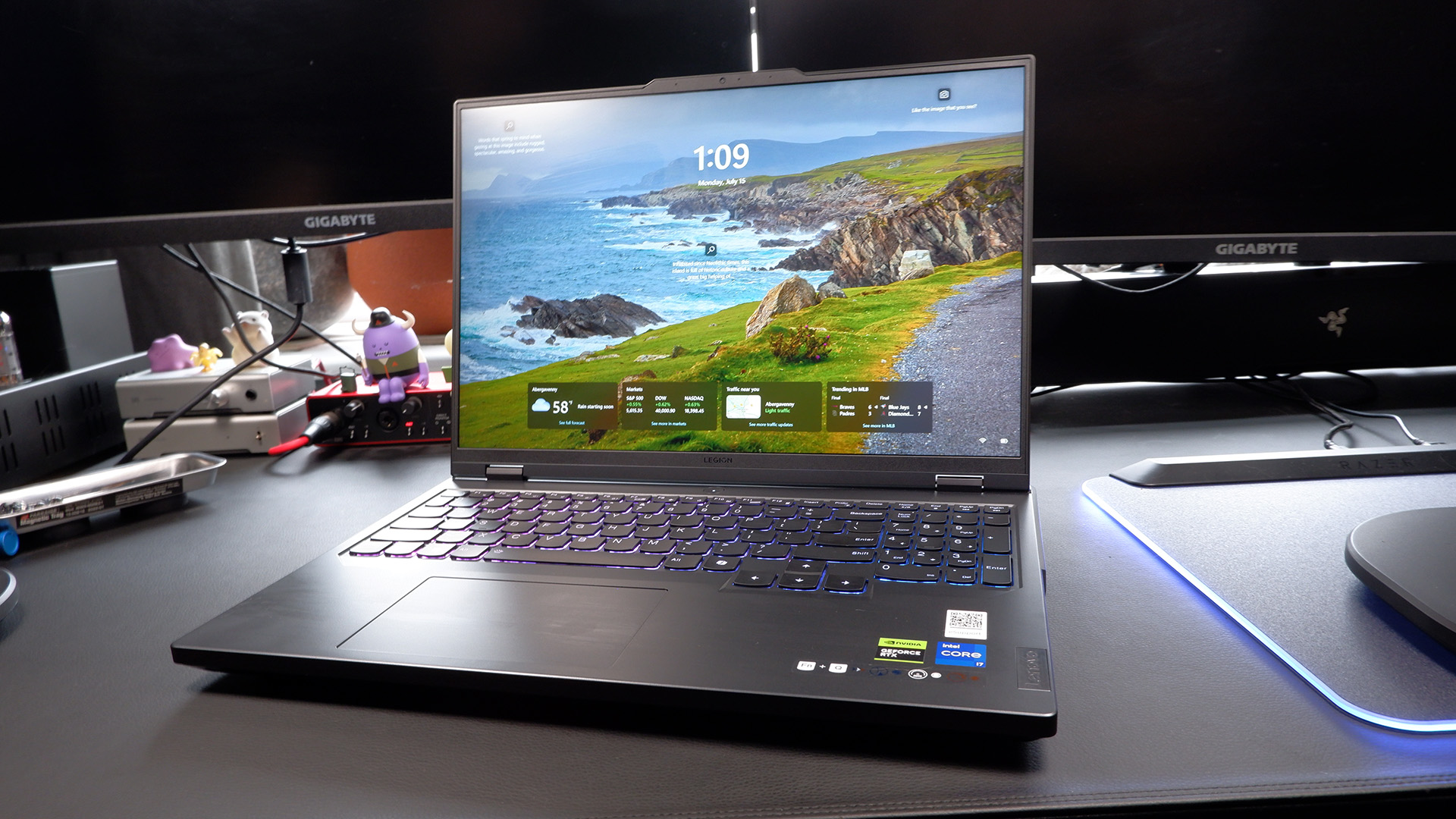
Excellent gaming performance doesn't make up for a lacklustre spec for the money.
Lenovo has sat in the top spot of our best gaming laptop guide for well over a year now—the Legion Pro 7i Gen 8 delivering a superb mix of performance, size and price. I had expected similar results from the Legion Pro 5i Gen 9. Instead, I’m feeling miffed by the new Gen 9 model. With impressive gaming performance, you’d think I’d be all over this thing and yet I can’t get over its lacklustre memory configuration and low storage capacity.
The Pro 5i Gen 9 comes equipped with one of the latest Intel Core processors, the Core i7 14650HX. It’s a mobile version of Raptor Lake, the same architecture currently leading the way on desktop for Intel. A 24-thread processor, divided into eight P-cores (16 threads with Hyper-Threading) and eight E-cores, that’s a lot of processing power for what is ostensibly a gaming laptop on the more affordable end of the market.
The GPU is very much a known quantity: the Nvidia GeForce RTX 4060 mobile, with 8GB of GDDR6 and rated to a total graphics power (TGP) of 140 W. That last bit is important, as this determines how much headroom the GPU has available to it and ultimately has a pretty significant impact on the overall gaming performance of the machine. The good news here is that 140 W is as good as it gets for the RTX 4060 mobile—a 115 W TGP with an extra 25 W boost—and it’s far and away the fastest RTX 4060 we’ve tested to date as a result.
(Image credit: Future)
CPU: Intel Core i7 14650HX
GPU: Nvidia GeForce RTX 4060 mobile (140 W)
RAM: 16 GB DDR5-5600 (1 x 16 GB)
SSD: 512 GB PCIe 4.0 NVMe (2x NVMe slots total)
Screen: 16-inch IPS w/G-Sync
Resolution: 2560 x 1600
Refresh rate: 165 Hz
Dimensions: 363.4 x 261.75 x 21.99-26.95 mm
Weight: 2.5 kg
Price: $1,520 (1 TB model)
Before we get to that shortly, we first need to talk about a few things the Pro 5i Gen 9 doesn’t do well.
It comes equipped with only a single stick of DDR5 memory, rated at 5,600 MT/s. While retaining 16 GB capacity—suitable for a laptop at this price point—a single stick limits the overall bandwidth. It could be much higher with dual-channel memory. While a single stick doesn’t appear to hinder the laptop hugely in many games I’ve tested—luck of the draw with our choice of tests—it could, it might, and it probably will at some point.
Single-channel memory also doesn’t scream ‘Pro’ to me, which feels like a miss on the ‘Pro 5i’.
The good news is you can easily access the laptop’s innards through 10 Phillips head screws. Adding a second stick or upgrading to an entirely new kit—the latter likely being preferable to avoid compatibility woes but running a higher cost—is as simple as removing the metal shield, popping the old stuff out, and slotting the new stuff in.
You’ll likely be in the undercarriage of this laptop at some point shortly after buying it, anyways. With that, let’s talk about the second disappointment.
The SSD in the Pro 5i is awfully small. It’s a measly 512 GB. When combined with a Windows 11 install and a few Lenovo pre-installed applications (including McAfee) it is a tight squeeze for a few major triple-A games. I ran into issues with storage space during benchmarking and had to uninstall one game to test another. Luckily I have a handy external SSD to transfer my game library to and from, which saves downloading games over and over, but if you don’t have one, you might have to rely on redownloading game files instead.
Though, again, you could pop the undercarriage off and add another larger gaming SSD. There’s a spare slot going—a small recompense for the lack of capacity out of the box.
The odd thing about the SSD is how it’s small but mighty. It’s one of the faster drives in our testing. That performance feels a little bit wasted, but it’d make for a fantastic boot drive alongside a much larger data drive in that second NVMe slot.
Once I opened this laptop up, I realised this isn’t your average cheapo gaming laptop. The cooling, motherboard, and layout inside the machine are much more impressive than most around this price or lower. That’s definitely saying something for this laptop—for PC builders comfortable with taking apart machines and installing new parts, it has plenty of headroom for upgrades. Though that’s mostly beside the point.
(Image credit: Future)
You shouldn’t have to be ripping the rear off your shiny new gaming laptop to fix what is a pretty poor configuration in 2024, at least at this price. I was unable to find a retailer selling this exact model (SN: 83DF000DUS), though Lenovo sells almost an identical unit with a 1 TB SSD for $1,520 (I’ve also seen it discounted to $1,274/$1,330).
That solves the storage problem, to some extent, though that model similarly comes with single-channel memory, according to Lenovo’s own specifications database, and you can buy an RTX 4060-powered Lenovo laptop for a whole lot less.
Or even an RTX 4070 for less.
What’s frustrating is that this laptop, with more memory and a larger SSD as standard, would be fantastic. The screen is a 16-inch IPS with a 165 Hz refresh rate and a 2560 x 1600, 16:10 resolution. The keyboard is a full-size unit with a numpad included and full RGB backlighting. There are tons of ports, a decent webcam with a privacy switch, and a responsive trackpad.
It’s all good stuff, except those few key misses.
(Image credit: Future)
Thankfully there is a saving grace for this machine. The gaming performance is absolutely awesome, somewhat bewilderingly for a laptop with single-channel memory. The extra oomph from the graphics wattage drives higher performance and it’s handled well thanks to its high-quality interior.
I’ve run multiple benchmarks on this laptop in Performance mode to get a feel for where it tops out across 1080p, 1440p, and its native resolution, 2560 x 1600. In most games, the Pro 5i Gen 9 performs exceptionally well, with performance-topping RTX 4060-powered machines.
This is the first RTX 4060 laptop we’ve tested with a 140 W TGP and it’s blazing the trail.
The GPU reaches a moderate 75°C under load while gaming, however, the CPU gets toasty at 100°C. What’s interesting is the high GPU clock of 2,709 MHz, which is higher than the comparable laptops shown in the charts and the result of a minor GPU overclock automatically applied in Performance mode, and yet an average wattage of only one 1 W higher than the Gigabyte G6X.
I have to admit I’m a little surprised at the results. I was expecting single-channel memory to hold this laptop back more so than it actually did.
That’s not to say I’m softening my stance on single-channel memory—at this price, this laptop should absolutely have dual-channel with 16 GB of memory—but practically it hasn’t made as much of a difference across our benchmarking suite as I’d thought it might. However, we do know that single-channel can have an impact on performance in some cases.
This gaming laptop isn’t strong on battery life. In running at RTX 4060 at a high wattage, the 80 WHr battery is unable to keep it juiced for long. Even once I turned off Performance mode and ran in standard Balanced mode with Hybrid GPU switching enabled (which will choose between iGPU and discrete GPU as required), the Pro 5i only mustered 41 minutes of battery life in the PCMark gaming battery benchmark.
(Image credit: Future)
(Image credit: Future)
(Image credit: Future)
✅ You aren’t afraid of getting under the hood: If you’re handy with a screwdriver, you’ll find a spare NVMe and SO-DIMM slot under the hood here for future expansion.
❌ You want the best value: There’s no getting around it, you’re paying a lot for a laptop with only half the SO-DIMM sticks and storage it probably should have.
❌ You’re chasing performance: It might be the fastest, most impressive RTX 4060 laptop around, but for the price of an RTX 4070 laptop.
❌ You want decent battery life: The power-hungry RTX 4060 here rinses the battery pretty quickly.
A few thumbs up and a few thumbs down, then—the Pro 5i is truly a mixed bag. The deciding factor is the price tag attached to this gaming laptop. Let’s just take the 1 TB model since 1) I can’t find a listing for the 500 GB model, and 2) I definitely wouldn’t buy the 500 GB model, anyways.
So, if I had the $1,520 (or even $1,274) asked of the 1 TB model to spend on a gaming laptop, would I spend it on this?
No, I wouldn’t. There are far too many great offers on gaming laptops right now that roundly beat this laptop where it counts. The HP Victus with a Core i7 13700H, 16 GB RAM, and an RTX 4070 is $1,199 right now. There’s also Lenovo’s own Legion Slim 5 with a Ryzen 7, 16 GB of admittedly single-channel RAM, and an RTX 4070 for $1,220.
Regardless of how well the RTX 4060 runs inside the Pro 5i Gen 9, it’s no match for the superior RTX 4070 silicon.
I like a lot about the Lenovo Legion Pro 5i Gen 9—that might sound weird for a laptop I’ve awarded a mere 58%—but with a few tweaks, it could be so much more impressive. The screen is good, the chassis is good, the internals are good. That said, I’m reviewing the spec in front of me and it’s not a very balanced machine. Not at all.
The Pro 5i’s performance could be undermined by its single-channel memory. Its high-wattage GPU obliterates the battery life. Moreover, it’s not competitive enough at its current pricing. Across three generations of comparable laptops with RTX 40-series GPUs, we’re not short of genuinely excellent gaming laptops to choose from today, and there’s no reason at all to buy this particular one.







